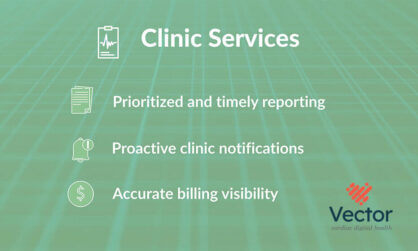How Implantable Loop Recorder Remote Monitoring Improves Atrial Fibrillation Care

ILRs combined with an effective remote monitoring program give you the insight you need to deliver faster, more effective AF management.
While an implantable loop recorder (ILR) is a critical tool for monitoring atrial fibrillation (AF) episodes, too often cardiac clinics lack the remote monitoring support they need to use these devices to their full potential. Let’s look at how ILRs work to better understand how you can use them to improve the way you deliver AF care.
What is an implantable loop recorder?
An ILR is a small device that is implanted subcutaneously in the chest near the heart. Once implanted, it passively records and stores electrocardiograms to identify arrhythmias. The device can record heart rhythms for up to three years, making it a convenient alternative to external Holter monitors. An ILR lets a patient shower, swim, sleep, and exercise without restraint, making it a superior alternative to an external monitor that a patient can only use comfortably for a relatively short time.
The ILR is always recording, enabling you to capture the true picture of the patient’s heart health. If the device detects a potential heart rhythm abnormality, it creates a snapshot to flag the event for review. Patients can also trigger the device to take a snapshot if they feel a symptom, such as shortness of breath or weakness. This enables you to see exactly what the heart was doing during the time of the symptom to better identify your treatment plan.
In addition to AF, you can use an ILR to monitor and diagnose a number of different arrhythmias and conditions, such as fainting, palpitations, and pausing.
How ILR helps manage atrial fibrillation
According to the CDC, atrial fibrillation is one of the leading causes of hospitalizations and deaths in the United States each year, with the death rate associated with AF on a steady rise over the last twenty years. According to the ACC (2014), AF is associated with a 5-fold increased risk of stroke, a 3-fold increased risk of heart failure, and a 2-fold risk of dementia and mortality.
With AF, irregular beating in the atria prevents blood from flowing properly to the ventricles. This decreases the heart’s ability to work, leading to symptoms like chest pain, difficulty breathing, faintness, fatigue, and palpitations. The blood can also pool in the pockets of the atria and become sluggish. This can result in the formation of blood clots. These symptoms and complications can be mild enough to affect a patient’s quality of life, or severe enough to force them to the emergency room. It can lead to stroke, heart failure, and other heart-related complications.
Episode duration and frequency are strongly correlated with adverse effects of AF; a patient who suffers from AF for one minute a month is at less risk than one who suffers multiple episodes a day. However, intermittent AF can be difficult to detect; it can be asymptomatic, known as silent AF, making it almost impossible to direct care using symptom-based monitoring.
With an ILR, you can identify the duration and frequency of AF even when a patient isn’t hooked up to an ECG so you can understand exactly what is going on and why. According to a review published by the Heart Rhythm Society, “Intermittent ECG monitoring techniques have been shown to underdiagnose AF events while having limited ability to characterize AF burden and density. Continuous long-term implantable loop recorder (ILR)–based ECG monitoring has been designed to overcome these limitations. This technology is being increasingly used to diagnose episodes of AF in high-risk patients and to improve characterization of AF episodes in patients with known AF.”
Compared to intermittent monitoring, monitoring a patient’s heart 24 hours a day for years at a time can increase your ability to identify and characterize your patient’s AF – or even if their symptoms are due to AF in the first place – so you can identify treatment options. One study showed it can also guide blood-thinning medication management to allow for the “safe withdrawal and obviate long-term use of oral anticoagulants (OACs) in AF patients at high bleeding risk.”
Overcoming the challenges of ILR management for AF
While an ILR is a powerful tool for patient care, it can be a tricky one to manage. First, there’s the issue of setting the patient up with everything they need to monitor the ILR. This involves sending the patient home with a monitor that wirelessly connects to the ILR nightly and transmits data to a device portal. Many patients struggle with the setup process and technical support, causing them to either call your office for help or skip monitoring entirely.
Once a patient is transmitting properly, the ILR can generate pages and pages of data per patient. A clinic with a heavy patient load may have to manually review hundreds of patient records a day, looking for needles in the haystack that identify the need for follow-up care. In addition, the potential for false positives requires extra work on your part to identify critical AF episodes while increasing the chance you miss a severe episode.
A solution like Vector can take all the hard work of ILR remote monitoring off your hands. Vector provides everything you need – from patient setup to transmission review – so you can focus on actionable AF data that enables you to be more efficient and productive. By ensuring you receive transmissions and that highly-trained cardiac device experts review every alert and episode, Vector helps cardiology care teams stay at the center of their patient’s care. Learn more about how Vector helps improve cardiac rhythm management.














